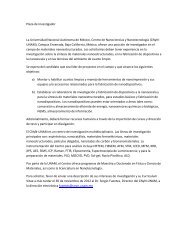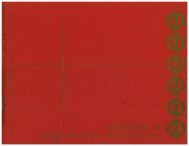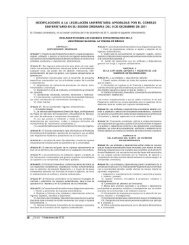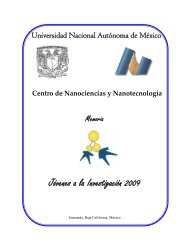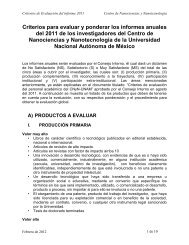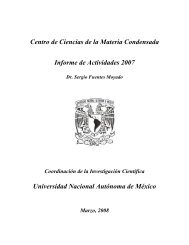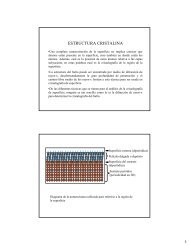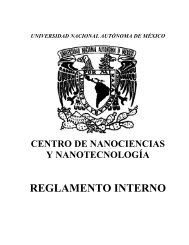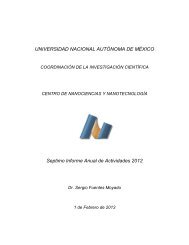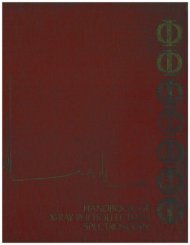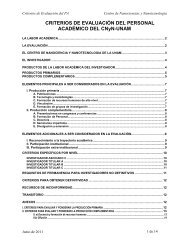Universidad Nacional Autónoma de México - CNyN
Universidad Nacional Autónoma de México - CNyN
Universidad Nacional Autónoma de México - CNyN
Create successful ePaper yourself
Turn your PDF publications into a flip-book with our unique Google optimized e-Paper software.
1st International Symposium on Nanoscience and Nanomaterials<br />
The current voltage (I-V) characteristics show rectifying nature with dynamic transfer resistance ratio<br />
of the or<strong>de</strong>r of 10 3 in the forward bias condition. Fig. 2 (a, b) show the current voltage characteristics in the<br />
forward and reverse bias respectively.<br />
Figure 2. I-V characteristics of p-n junction consisting of p-NiO and n-ITO thin films.<br />
In the forward bias condition the curve, as shown in fig. 2 (a), exhibit the rectifying properties,<br />
indicating proper formation of the junction. Fairly high current values of the or<strong>de</strong>r of 300 µ A has been<br />
obtained at 0.35 V and the turn-on voltage obtained ~ 0.06 V. A small leakage current as low as 12 nA was<br />
observed at a reverse bias of –5 V. Previously, Tonooka and co-authors [3] reported the average turn on<br />
voltage of their n-ZnO / p-Cu-Al-O dio<strong>de</strong> ~ 0.5 V, which is higher than our p-NiO/n-ITO dio<strong>de</strong>The observed<br />
optical and electrical properties of oxi<strong>de</strong> transparent dio<strong>de</strong> are attributed to the heteroepitaxial nature and<br />
carrier diffusion at the junction interface.<br />
1. A.J. Freeman, K.R. Poeppelmeier, T.O. Mason, R.P.H. Chang, T.J. Marks, MRS Bull. (August) (2000) 45.<br />
2. J.F. Wager, Science 300 (2003) 1245.<br />
3.Tonooka K, Bando H, Aiura Y, Thin Solid Films, 445 (2003) 327<br />
P-028<br />
INSITU FORMATION OF GOLD NANOPARTICLES COATED WITH POLY(N,N´-<br />
DIETHYLAMINOETHYLMETHACRYLATE)<br />
A. Licea-Claveríe 1,a , N.A. Cortez-Lemus 1 , G. Alonso-Núñez 2 and F. Paraguay-Delgado 3<br />
1 Centro <strong>de</strong> Graduados e Investigación, Instituto Tecnológico <strong>de</strong> Tijuana, A.P. 1166, 22000 Tijuana, B.C.,<br />
México.<br />
2 Centro <strong>de</strong> Nanociencias y Nanotecnología <strong>de</strong> la <strong>Universidad</strong> <strong>Nacional</strong> Autónoma <strong>de</strong> México, KM 107<br />
Carretera Tijuana-Ensenada, C.P. 22860 Ensenada, B.C., México<br />
3 Centro <strong>de</strong> Investigación en Materiales Avanzados (CIMAV) S.C., C.P. 31109 Chihuahua, Chih., México<br />
a aliceac@tectijuana.mx<br />
Keywords: Polymers, Nanoparticles, Gold, polyelectrolytes.<br />
Gold nanoparticles (AuNPs) have been the focus of intense research over the past <strong>de</strong>ca<strong>de</strong> due to their<br />
unique properties and potential application in many areas including biomedical materials, optics, electronics<br />
and catalysis. Thiol chemistry has been wi<strong>de</strong>ly used to modify the surface of AuNPs with different molecules,<br />
including polymers. Recently, there have been numerous reports utilizing amine containing copolymers that<br />
can act as both a reducing agent and a stabilizing agent in the synthesis of AuNPs. In this contribution we<br />
report the use of RAFT polymerization to prepare poly(N.N´-ditehylaminoethylmethacrylate) (PDEAEM)<br />
40




